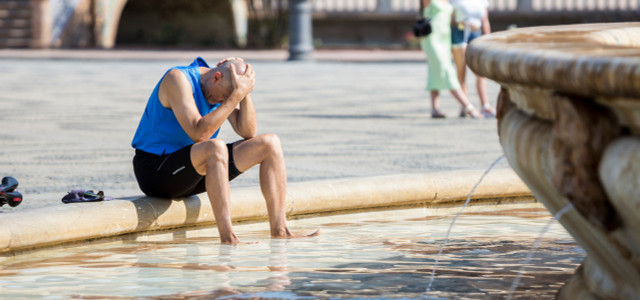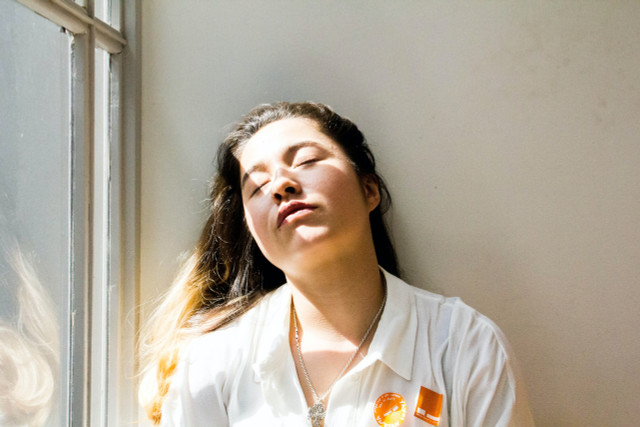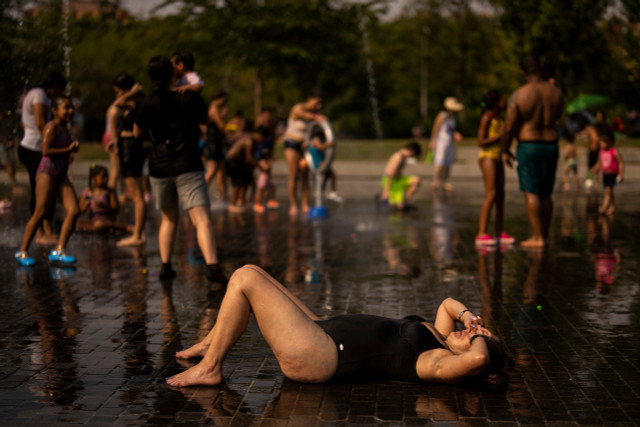
It’s hot and that often has consequences for your health. High temperatures can quickly lead to a heat emergency. We show you how to recognize the signs and act correctly.
When it is hotter than 30 degrees, the most important thing is to take care of your own health. To protect yourself from the dangers of heat, you should follow several tips, for example: drink a lot, avoid physical exertion in the blazing sun and ideally find a shady spot in loose, airy clothes. But what if it gets too much and people suffer a heat emergency? We show you what types of emergencies there are and what you should do in these situations.
Take heat exhaustion seriously
It sounds harmless at first: being exhausted from the heat. After all, we are all a bit overwhelmed by very high temperatures and people usually have difficulty concentrating in the heat (for long periods of time), let alone performing at their best. Exhaustion is not uncommon.
However, heat exhaustion is a serious health phenomenon that occurs when exposed to excessive heat.
How do you recognize heat exhaustion?
Depending on the extent of exhaustion, different and sometimes very unspecific symptoms occur. The first signs usually include thirst, dizziness, coordination problems, fatigue and muscle pain. The following symptoms can also occur:
- weak but faster pulse
- headache
- nausea and vomiting
- shortness of breath

What can you do?
First, the affected person should rest, because what initially begins as heat exhaustion can quickly progress to heat stroke.
- First, you should move the person out of the sun to a cooler and shady place.
- Then you should cool them down with cold water and towels, for example.
- The person should have something to drink (ie water, unsweetened herbal or fruit teas, heavily diluted spritzers).
- In the case of children, the elderly and people with a weakened immune system, it is particularly important to act quickly.
- If there is no improvement, medical advice should be sought. In case of (rapid) deterioration, it is advisable to call an ambulance.
Ideally, heat exhaustion can be avoided in the first place.
Emergency for heat stroke
The word already sounds threatening: heat stroke. And the name couldn’t be more apt, because in this case the heat literally knocks you out. In this heat emergency, particular urgency is required and you should react immediately if you notice symptoms, otherwise heat stroke could be fatal.
How do you recognize heat stroke?
Heat stroke is also one of the so-called heat injuries. You can recognize it by the following symptoms:
- high body temperature up to 40 degrees Celsius
- accelerated pulse
-
Dizziness, headache and nausea
- lack of sweat production
- hot, dry and red skin
- drowsiness
If the heat stroke is not noticed in time and counteracted, it will also happen later
- a drop in blood pressure,
- Circulatory collapse and associated shock
- as well as unconsciousness.
Due to the collapse of the entire cardiovascular system, the organs are no longer supplied with sufficient blood and oxygen. This can lead to shortness of breath, fainting or seizures. Without medical treatment, heat stroke can, in the worst case, lead to death.

What can you do?
If you see someone who may be suffering from heat stroke, or if you think you might be affected, you should call 911 immediately. In the case of children, the elderly and people with a weakened immune system, it is particularly important to act quickly.
- As a first aid measure, you should remove the affected person from direct sunlight. It doesn’t matter whether you put the person inside a building or just under the shade of a tree. It is important that it is no longer exposed to direct sunlight.
- Try to lower the affected person’s body temperature: You can do this by removing clothing, putting on ice packs and using wet compresses. If possible, a bath in cool water will also help.
- Bring the affected person into the so-called shock position: You lie on your back and put your legs up. In this way, the brain is better supplied with blood.
- If the affected person is still responsive, the fluid loss should be compensated. You should use lukewarm drinks for this.
Important: If the affected person is no longer conscious, it must be checked whether they are still breathing. If not, mouth-to-mouth resuscitation must be administered immediately and until emergency services arrive. In addition, the respective person should be positioned in the stable lateral position. In the event of heat stroke, always call a doctor.
You should never leave a person with heat stroke alone, as the course of the disease is often extreme and can change quickly.

Heat emergency sunstroke
Sunstroke is also a potentially life-threatening heat emergency. You should also react quickly here and take the signs seriously, especially since sunstroke can also worsen and develop into heat stroke. In the worst case, this ends fatally.
How do you recognize sunstroke?
Depending on the severity of the sunstroke, also known medically as heliosis or insolation, the signs can vary in severity. If you have the following symptoms, you should suspect sunstroke:
- hot, crimson head and/or neck while remaining skin appears normal
- severe headache that gets worse when you bend your head forward
- Nausea, retching and vomiting
- tinnitus
- inner unrest
- dizziness
- drowsiness
- exhaustion
- stiff neck
- in severe cases: symptoms such as disorientation and loss of consciousness
What can you do?
- Put yourself or the affected person in the shade.
- Lay you (or the person with sunstroke) flat on the floor. Position your head and upper body slightly elevated.
- Open or remove tight clothing.
- Cool your head, neck and neck with cold, damp towels.
- Fresh air can also help – use a fan or a fan, for example.
Important: If the affected person is unconscious, an ambulance must be called immediately and first aid must be provided.
Duration: Typically, the signs and symptoms of sunstroke last from several hours to two days. Duration and severity depend on how long one has been exposed to the sun, but also on age and health. The most important thing here is: get out of the sun and heat!
Prevention and prudence is the best medicine
The basic rule is to pay particular attention to yourself and your fellow human beings when it is hot. Especially with older people and babies you should be attentive and interpret signs correctly. But it is better if you prevent emergencies in a targeted manner and ensure that these people have sufficient sun protection as well as enough cooling and sufficient water. Drinking is often neglected by these groups of people (even when it is hot) because the sense of thirst is limited or it is no longer possible to communicate that you are thirsty. We have put together what you should look out for when it is hot for seniors and babies and how you can get through heat waves.
Read more on Techzle.com:
- 5 instant tricks you can use to save electricity permanently
- Vegan ice cream is all the rage: the best brands and recipes
- Sun protection for the baby: everything you need to know for the trip outdoors